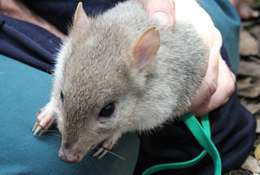Eastern bettongs bounce back

(Phys.org) -- The release of Eastern bettongs from Tasmania into the ACT’s predator-proof sanctuary at Mulligans Flat Nature Reserve last week, could be the key to help recover endangered Box Gum grassy woodlands, according to research from The Australian National University.
Associate Professor and ARC Future Fellow Dr. Adrian Manning from the Fenner School of Environment and Society, part of the ANU College of Medicine, Biology and Environment, said bettongs (Bettongia gaimardi) are considered to be ‘ecosystem engineers’, but became extinct in the woodlands of mainland Australia more than 80 years ago due to feral predators, habitat loss and eradication by humans.
“By disturbing the earth while digging for truffles and other native fungi, these small marsupials turn over large quantities of soil, which leads to improvements in the infiltration of water and nutrients, and helps seedling germination and the spread of fungal spores that are critical to woodland health,” Dr. Manning said.
“Our team of ecologists is trying to understand how these reintroduced animals impact on woodland ecosystems, and then examine if they can be used by land managers as an ecological restoration tool to repair Box Gum grassy woodlands.”
The reintroduction of Eastern Bettongs is part of a larger research project, The Mulligans Flat and Goorooyarroo Woodland Experiment, which is led by Dr. Manning.
The experiment is examining effective ways to restore grassy woodlands in a partnership between the ACT Government, CSIRO and the James Hutton Institute in Scotland. The project is taking place at the Mulligans Flat and Goorooyarroo Nature Reserves on the northern edge of the ACT.
“Together the reserves are an important ‘outdoor laboratory’ for learning about the restoration of grassy woodlands. The research on bettongs and other restoration treatments should provide the ACT Government and other managers of woodlands with sound evidence to better conserve one of Australia’s most endangered ecological communities,” Dr. Manning said.
“We hope the project will be a catalyst for changing thinking about how to rebuild our lost ecosystems and secure the future for the threatened species that are dependent upon woodland habitats.”
The project is funded by the Australian Research Council and ACT Government, and has been running since 2004.
More information:
www.environment.act.gov.au/cpr … tern_bettong_project
www.mfgowoodlandexperiment.org.au/
www.mulligansflat.org.au/
Provided by Australian National University

















